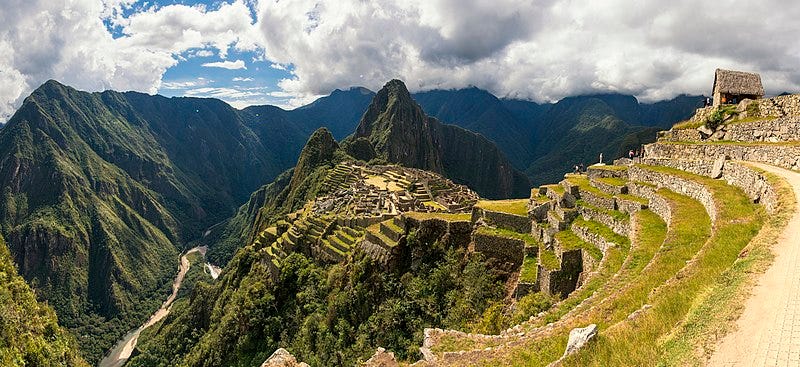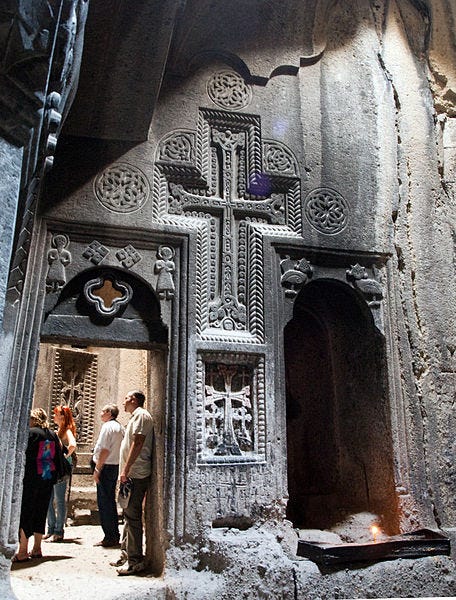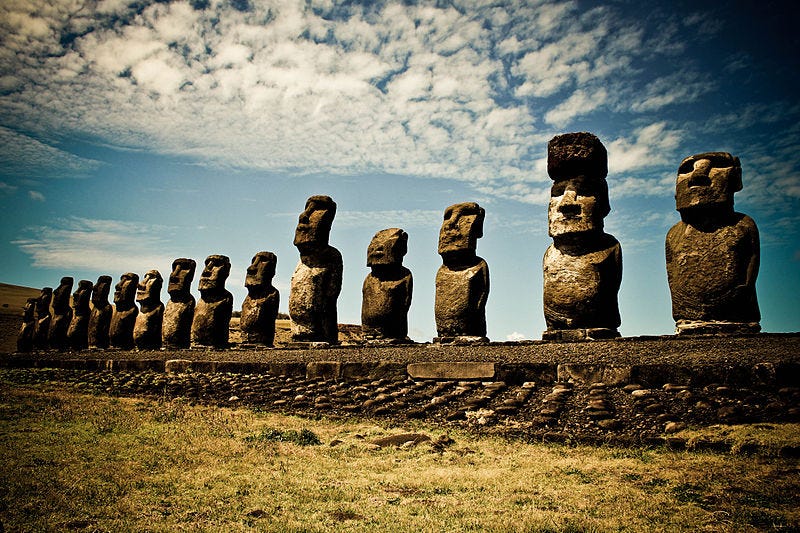Building civilizations without distinguishing between ‘she’ and ‘he’
For millennia, much of human society has been getting by just fine with gender neutral third person pronouns.
Let’s visit UNESCO World Heritage sites on 5 different continents, all of them built by people whose modern descendants are still speaking languages that have NO gender differentiation for third person pronouns.
Great Wall of China

The Great Wall of China is the largest architectural structure in human history.[1] More than 13,000 miles long,[2] it was built over 2 millennia by successive Chinese dynasties.[3]
There are about 1.3 billion speakers of Chinese worldwide.[4] Spoken Chinese does NOT differentiate between “she” and “he”. In Mandarin Chinese, the second most widely spoken language in the world, the third person pronoun is ‘ta’. And prior to the 20th century, written Chinese did not distinguish between “she” and “he” either. [5]
Machu Picchu in Peru

Machu Picchu is a 15th century Incan citadel built from stones fitted together without the use of mortar.[6] This spectacular monument to the Incas’ architectural ingenuity is Peru’s most popular tourist site.[7] Its name came from Quechua[8], the language of the Inca Empire.[9] Quechua is spoken by approximately 7.7 million people today.[10] The Quechuan third person pronoun ‘pay’ is gender neutral.[11]
Great Zimbabwe

The stone city of Great Zimbabwe was built in the 11th c. and maintained through the 15th c. by the ancestors of the modern Shona people.[12] A 16th c. Portuguese visitor described it as “… a fortress built of stones of marvelous size, and there appears to be no mortar joining them ... This edifice is … surrounded by … others resembling it in the fashioning of stone and the absence of mortar, and one of them is a tower more than 12 fathoms [22 m] high.”[13]
Great Zimbabwe is the largest pre-modern stone complex in sub-Saharan Africa.[14] The soapstone birds found at the site are a national symbol of modern Zimbabwe[15], where the Shona ethnic group are 80% of the population.[16] The Shona languages, which have more than 7 million speakers across Zimbabwe, Mozambique, Zambia and Botswana[17], does not differentiate between ‘she’ and ‘he’. The third person pronoun is ‘iye’.[18]
Geghard Monastery in Armenia

The monastic complex of Geghard was founded in the 4th century when Armenia became the first country to make Christianity its state religion. Monks lived in the caves in the nearby cliffs. In the 13th century, the princely Proshyan family further developed the site, adding ornately carved chapels and churches that were partially or entirely cut into the rock of the surrounding mountain.[19]
Formerly known as Arivank (“monastery of the cave”), the site later acquired the name Geghardavank, which means "monastery of the spear" in Armenian because the spear head that was believed to have touched Jesus was once kept there.[20]
Armenian, which has about 6.7 million speakers worldwide,[21] does not have separate pronouns for ‘he’ and ‘she’ – the third person pronoun is the gender neutral ‘na’.
Xochimilco in Mexico

The chinampas of Xochimilco are floating islands built by the Aztecs in the 15th century to create more agricultural land for their growing population.[22] Xochimilco, once an independent city but now a borough of Mexico City, means "flower garden" in Nahuatl (the language of the Aztec Empire). [23]
There are approximately 1.5 million Nahuatl speakers in central Mexico.[24] The Nahuatl 3rd person pronoun is yehuātl.[25] Unlike the colonial language Spanish, Nahuatl does not have grammatical gender.[26]
Moai Monoliths of Rapa Nui

Between the 13th to 18th centuries, the people of Rapa Nui built close to a thousand stone statues, the tallest of which is 10 meters tall and weighs 82 metric tons.[27] The transportation and installation of these massive statues, known as moai in the Rapa Nui language, is considered a remarkable feat of engineering.[28]
The Rapa Nui language, like most other languages in the Austronesian family, does not have gender differentiation for the 3rd person pronoun. The equivalent of ‘she’ or ‘he’ is ‘ia’. [29]
Other Austronesian languages with gender-neutral 3rd person pronouns include Tagalog (‘siya’), Malay (‘dia’) and Hawaiian (‘ia’). There are about 1200 Austronesian languages, comprising about 1/5 of human languages[30], with 386 million speakers around the world.[31]
More languages that do not distinguish between ‘she’ and ‘he’
The Turkic languages, with approximately 230 million speakers,[32] is another major language family whose third person pronouns are gender neutral.[33] In Turkish, the most widely spoken member of the Turkic family, ‘she/he/it’ is ‘o’.
Other widely used languages that do NOT differentiate between ‘she/he/it’ include:
Swahili – with more than 200 million speakers, it is one of the 10 most widely spoken languages in the world.[34] The third person pronoun is ‘yeye’.[35]
Persian - with about 70 million speakers,[36] it is spoken in 8 countries across West Asia and Central Asia. The third person pronoun is ‘u’.[37]
Yoruba - with about 44 million speakers, it is one of the 9 most widely spoken languages in Africa. [38] The third person pronoun is ‘oun’.[39]
Fulfude/Pulaar – with more than 37 million speakers, it is used across 18 countries in West Africa.[40] The third person pronoun is ‘omo’.[41]
Bengali/Bangla –284 million people across Bangladesh and India speak Bengali. It is the national language of Bangladesh. The third person pronoun is ‘se’.
Mandinka – more than 2 million people across Senegal, Guinea-Bissau and the Gambia speak Mandinka. The third person pronoun is ‘a’.
And this is only the tip of the iceberg. According to Lisa Wade, PhD, sociology professor at Tulane University, about 57% of the world’s languages do not differentiate between “she” and “he”.[42]
[1] Great Wall Of China - WorldAtlas
[2] Great Wall of China - Length, Map & Facts | HISTORY
[3] Great Wall of China - Han, Yuan, Dynasties | Britannica
[4] Chinese - Worldwide distribution (worlddata.info)
[5] The Story of a Pronoun (escholarship.org)
[6] Machu Picchu architecture: The buildings of the Incas explained (annees-de-pelerinage.com)
[7] Historic Sanctuary of Machu Picchu - UNESCO World Heritage Centre
[8] Machu Picchu: facts, history and meaning- Lonely Planet
[9] Quechuan languages | Andean, Indigenous, South America | Britannica
[10] Quechua languages (omniglot.com)
[11] ▷The 【personal pronouns in Quechua】 💥 Free Quechua course (aprenderquechua.com)
[12] Great Zimbabwe (11th–15th Century) | Essay | The Metropolitan Museum of Art | Heilbrunn Timeline of Art History (metmuseum.org)
[13] Newitt, M. D. D. (2002). East Africa. Vol. 2. Ashgate. p. 39.
[14] » Great Zimbabwe (smarthistory.org)
[15] Zimbabwe Bird (victoriafalls-guide.net)
[16] An Introduction To Zimbabwe's Shona People (theculturetrip.com)
[17] Shona language resources (mongabay.com)
[18] Shona Grammar - Quick Online Learning (ilanguages.org)
[19] Monastery of Geghard and the Upper Azat Valley - UNESCO World Heritage Centre
[20] Geghard - World History Encyclopedia
[21] Armenian language | History, Alphabet & Dialects | Britannica
[22] In Xochimilco, Mexico City, Aztec-Era Floating Gardens Offer a Path to Sustainable Eating | Condé Nast Traveler (cntraveler.com)
[23] Xochimilco Floating Gardens of Mexico City (tripsavvy.com)
[24] Nahuatl - Endangered Language Alliance (elalliance.org)
[25] Classical Nahuatl/Pronouns - Wikibooks, open books for an open world
[26] Nahuatl’s Lack of Grammatical Gender | by David Bowles | Medium
[27] New Moai statue that 'deified ancestors' found on Easter Island | Live Science
[28] 12 Things You Didn't Know About The Moai Statues (thetravel.com)
[29] Learn to speak Rapa Nui language (easterisland.travel)
[30] Austronesian languages | Origin, History, Language Map, & Facts | Britannica
[31] Language Families of the World - WorldAtlas
[32] Turkic languages - Simple English Wikipedia, the free encyclopedia
[33] Equity, Diversity & Inclusion | Middle Eastern Languages and Cultures | University of Washington
[34] Swahili gaining popularity globally | Africa Renewal (un.org)
[35] Swahili-individual-language Grammar - Pronouns (polyglotclub.com)
[36] Persian - Worldwide distribution (worlddata.info)
[37] Personal Pronouns - Persian Grammar (jahanshiri.ir)
[38] The 9 Most Spoken Languages in Africa — Complete Guide (discoverdiscomfort.com)
[39] Yoruba Grammar → Pronouns (polyglotclub.com)
[40] Fula language - Wikipedia
[41] Pronouns in Fulfulde – Resources for Self-Instructional Learners of Less Commonly Taught Languages (unizin.org)
[42] Map of the Week: 57% of Languages Do Not Have Gendered Pronouns - Sociological Images (thesocietypages.org)

